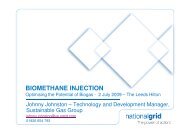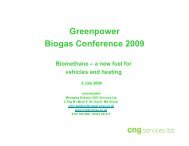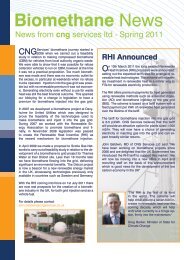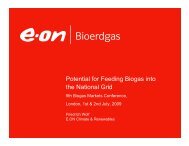Bio-SNG - CNG Services
Bio-SNG - CNG Services
Bio-SNG - CNG Services
Create successful ePaper yourself
Turn your PDF publications into a flip-book with our unique Google optimized e-Paper software.
BIO-<strong>SNG</strong> FEASIBILITY STUDY – ESTABLISHMENT OF A REGIONAL PROJECTA further important comparison was also made by North Energy – comparing the greenhouse gas savingsfor the direct use of biomass for heating with that via <strong>SNG</strong>. Using the RED methodology for forestryresidue woodchip feedstock, the specific emissions for direct heating is 13kgCO 2 e/MWh th and theemissions for <strong>Bio</strong>-<strong>SNG</strong> is 15kgCO 2 e/MWh th , compared with emissions from oil and gas heating at 313and 245 kgCO 2 e/MWh th respectively. Therefore the savings in both cases are approximately 95%compared with fossil fuel, and importantly the saving using <strong>Bio</strong>-<strong>SNG</strong> is essentially the same as usingdirect heating, but with elimination of any demand-side modifications for the heat users via the <strong>SNG</strong>route.The annual CO 2 e savings for three of the larger facilities operating on biomass is 1Mte of CO 2 e perannum if used to displace natural gas heating, and slightly higher if it displaces conventional transportfuel. If <strong>Bio</strong>gas were to displace a third of the domestic natural gas consumption and bio-<strong>SNG</strong>represented two thirds of that, then the CO2e savings would be ~15Mte pa when fuelled by biomass.7.2 COST OF CARBON ABATEMENT VIA BIO-<strong>SNG</strong>As discussed above, the use of <strong>Bio</strong>-<strong>SNG</strong> from biomass gives a typical CO 2 e saving equivalent to at leastthat of the tailpipe emission of fossil fuel it displaces, for heating and transport. Furthermore, a bio-<strong>SNG</strong>vector provides approximately the same saving as that achieved by direct use of biomass for heating.Strategically the UK needs to consider the most cost effective approach for decarbonising. An analysishas been undertaken which considers the cost of decarbonising, based on the current and proposedlevels of renewable support subsidy 52 considered to be adequate to achieve market penetration of theparticular technology.In this analysis, it is assumed that the existing RO regime, the proposed RHI regime and the existingtransport fuel differentials are sufficient to bring about market penetration of the technologies supported,that is to say, these incentives represent the necessary additional cost of delivered utility (heat, electricityand motive power) to a consumer compared with the conventional fossil fuel alternatives. It is alsoassumed that at present the cost of carbon under the EU ETS where it applies has simply been absorbedinto the baseline cost of electricity across the board, and due to free allowances does not at presentrelate to the cost of avoiding carbon emissions. Furthermore it is assumed that the existing infrastructure(both gas and electricity) have sufficient capacity and so no further investment is necessary specificallydue to the expansion of the carbon abatement pathway.52 In deriving the cost of the emissions savings, the Government’s Impact Assessments calculation is made on thebasis of dividing the NPV of the incentive by the total tonnes of CO 2 abated [noting that the cost is discounted overtime, but the carbon abated is not]. The analysis here is viewed from the point of view of the direct cost to theconsumer, ie the subsidy cost divided by the tonnes of CO 2 saved, and where possible uses the full lifecycleemissions of CO 2 e.64









